The last several months, we have paired our “Theology Tuesdays” with further issues related to or flowing from a recent or upcoming sermon. Today, we are answering a question from a church member related to giving. Specifically, should we pass the offering plate, have a box in the back, etc.
Great question! And this is a “Stab” at it. Not meant to be an exhaustive list. There will be some links at the end for further study.
And it is kind of random – but read through and let us know if you have any questions.
Short Answer
The Scripture does not say that one way of collecting a church’s (financial) giving (e.g., passing an offering plate, have a collection box, etc.) is “greater” or “better” than another. Nor does it say one is “sinful” and “one is not sinful.” It just gives biblical principles for giving.
Is the tithe still for today?
This is a really big question! What is below is as short of an answer I can make it. At the end of this blog, I will post some pro/cons.
Here we go…
Over the centuries since Christ’s return to heaven (ascension), many different arguments have been made for the tithe continuing versus it being fulfilled in Christ. No one “Christian view” has been established through all these years. Fellow believers have “agreed to disagree” on this many times – even quoting a multitude of biblical passages in support of a continued tithe or not.
From this writer’s (Darin’s) understanding of the biblical text, tithing in the Old Testament can be summed up as follows:
1. Before Moses, no tithing system existed, nor was there a command to tithe.
2. After God gave Moses the law, the Israelites were commanded to go above-and-beyond the 10-percent requirement. What’s more, only things connected to the land were liable to tithing.
3. All the books written by the prophets and the historical books contain no clear passage that indicates an Old Testament-type tithe is still in play today.
Verses to study: Deut. 16-17; 2 Chron. 31; Amos 4; Malachi 3, etc.
What about the New Testament? Some short overview:
1. Verses that use the word “tithe” in the New Testament (Matt. 23:23, Luke 11:42) do not suggest that the tithe continues.
2. Other passages (1 Cor. 16:2; 2 Cor. 8-9, Phil. 4, etc.) do not command or discuss a certain percentage for true Christians to give. Rather, biblical principles are laid out (we will discuss more below) that are in contrast to tithing.
3. Verses such as Galatians 6:6, 1 Timothy 5:17, and 2 Corinthians 8-9 lead this writer to conclude that the issue of giving, not tithing, was essential to the local church in the first century.
4. So, if Paul never actually discuses tithing, does it suggest the New Testament is silent on giving? Nope! As we will see below, specific instructions are given for giving now that we are under Christ.
To put in simply: No amazing argument, it seems, has been found in the New Testament that:
1. The Old Testament-type tithe continues…or that….
2. Christians are still obligated to it.
3. Tithing has been—to use the writer of Hebrews favorite term—"once and for all” fulfilled in Christ (See: the whole book of Hebrews, Romans 10:4, and Matthew 5:17-20, etc.).
Some Guiding Principles
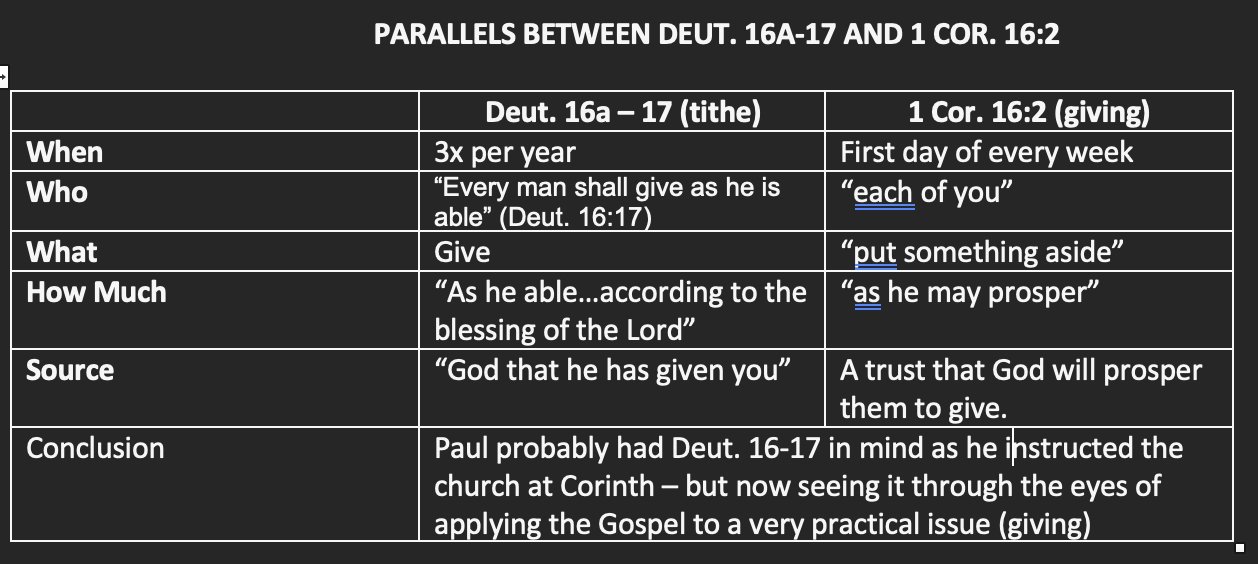
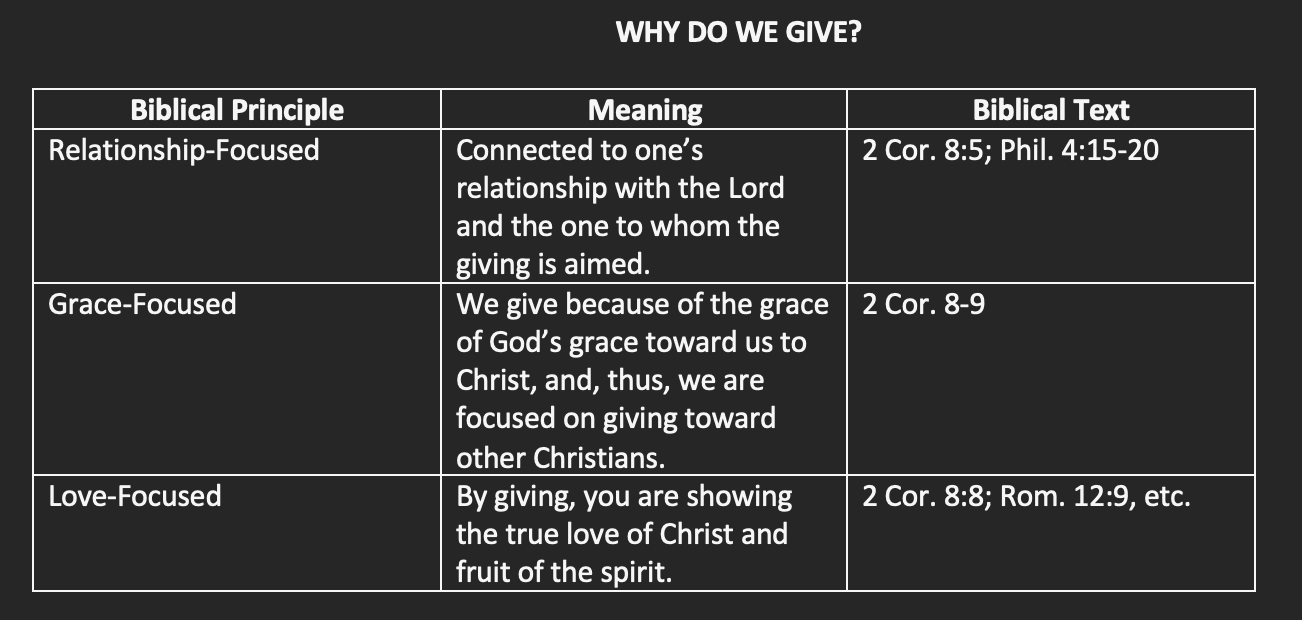
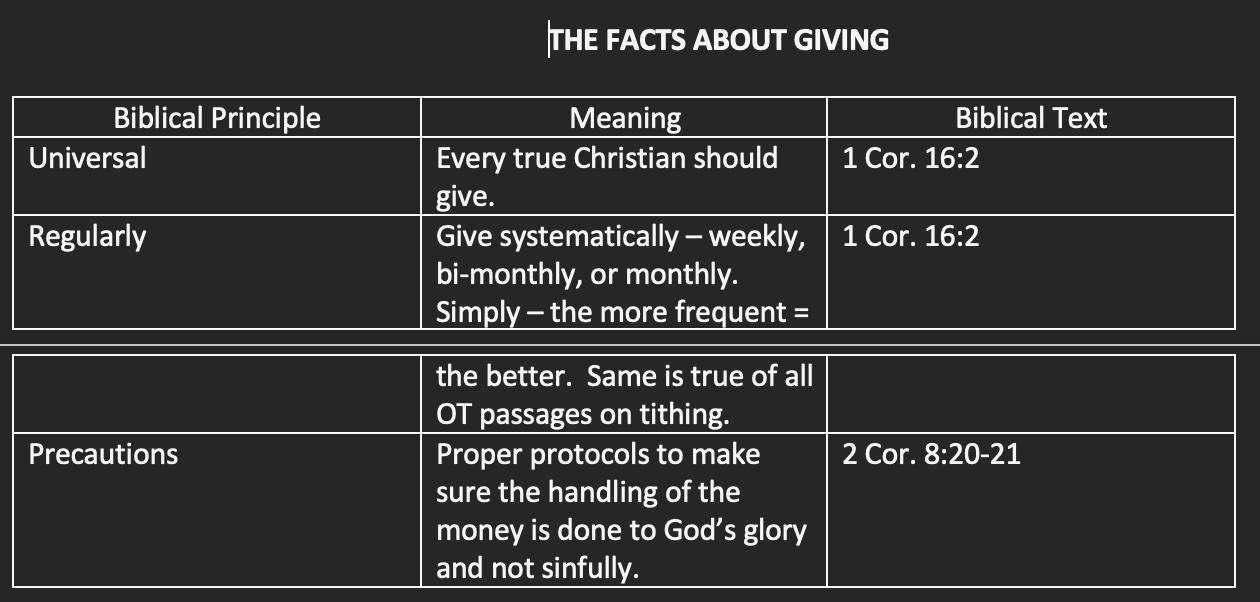
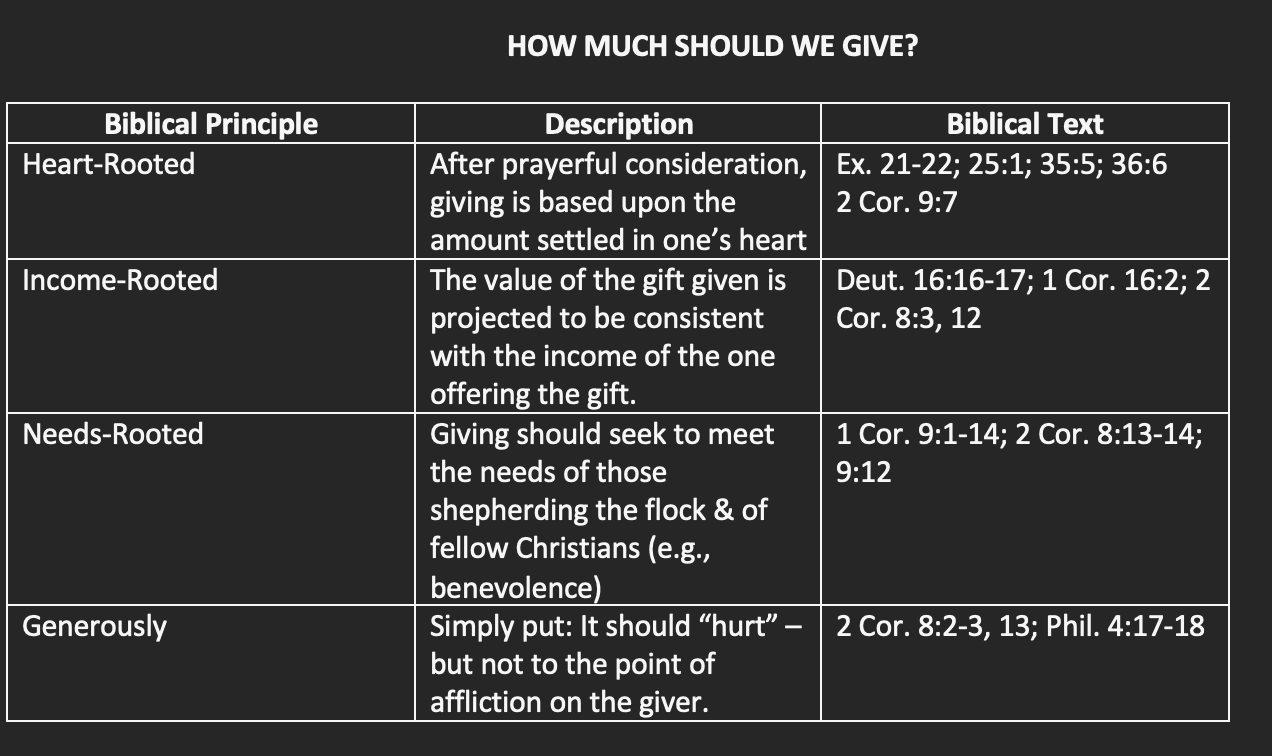

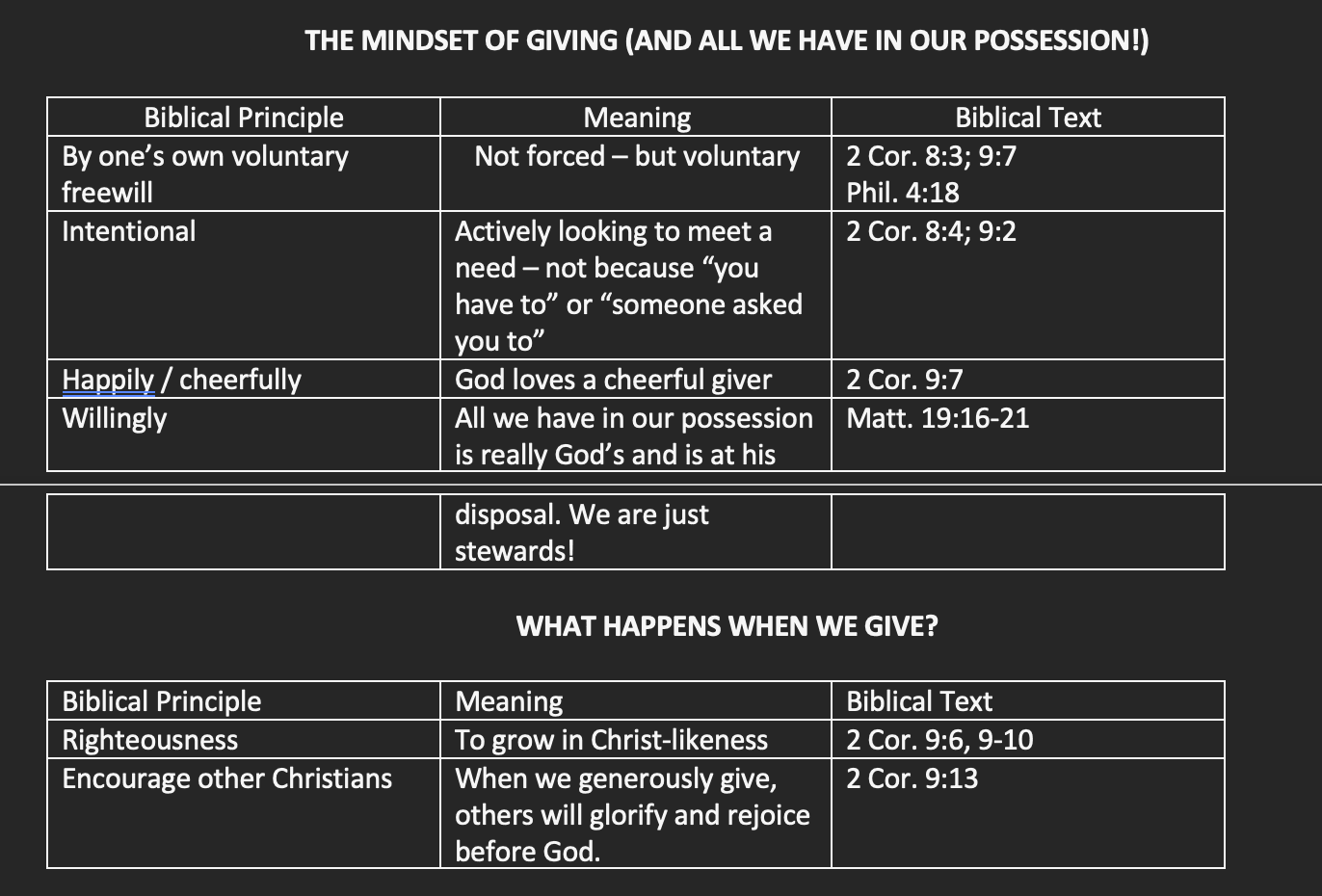
Certainly, this list is not an end-all, exhaustive treatise!
Bottom-line: It all comes down to one’s relationship with the living God through the risen Son, Jesus Christ. Obedience boils down to our relationship and understanding of who God is, what we are called to do, and how what we have impacts all of this to his glory. Whether it is one, thirty, fifty, or one-hundred percent in giving, we need to faithfully follow whatever the Lord asks us to do.
Faithful obedience to his leading, wisdom, and guidance is required.
Plate or Box?
Examples
· Both the Pharisees (in pride) and the widow (in humility) gave their tithe in a giving box-type treasury box (Luke 21:1-4).
· The early church shared it amongst themselves (Acts 2:46-47).
· Ananias and Sapphira laid their offering at the apostles’ feet (Acts 5).
· It was “put aside” (1 Cor. 16:2) in the church at Corinth.
· A “full payment” was handed to Paul by representatives from the church at Philippi (Phil. 4:18).
· The writer of Hebrews commanded the readers to “share what you have” (13:16) – yet, with no specific way or how.
· James reminded his readers always give “things needed for the body” (Jas. 2:16 ESV) in reference to another Christian in need.
· John exhorted his readers, as they saw their brothers “in need”, to share the “world’s goods” (1 John 3:17).
Giving Motivation and Method
So, after all this, let’s talk about where we are at Tower View.
Currently, we have an offering box in the back of the auditorium and online giving. Before March 2020 and the start of the COVID pandemic, we mainly passed plates and had some online options.
As with anything in church life, there are pros and cons to every decision, including the choice of how to handle offerings. (As a reminder: this is not a primary doctrine, so Christians may, in love and unity, disagree on this!).
But there are a couple of reasons why we’ve (least for now) decided not to pass the plate.
Passing a plate or a basket is a visible, public way of giving. Other people can see whether you gave or not; they might even be able to see how much you gave. Because of that, people can feel pressured to give. They may end up giving reluctantly or under compulsion, which is exactly what 2 Corinthians 9:7 warns against. Because other people are watching, they may give in order to impress onlookers or earn praise from others—which is the wrong motivation (Matthew 6:1-4).
In addition, the fact that part of each service is focused on collecting money can give some people (especially newcomers or those who are not yet believers) the wrong impression. It can feed into negative stereotypes about how churches are focused on money, or make it seem like there is a price of admission into the church family.
Of course, giving to support kingdom work is a good, biblical thing, and we should encourage people to be faithful and generous in how they give. It’s just that having a public offering plate isn’t necessarily the best way to do that.
How We Help People Give
The goal should be to make it easy for people to give privately.
The first way we do that is by having a giving box placed at the entrances to our auditorium.
Yes – It is just as easy for people to put money into the boxes as it would be for them to put it into a plate. True. It seems the difference is that people can be as discrete as they want to be, slipping in an offering as they pass by.
Of course, people can also mail in checks if they want, which is a second way of giving privately.
However, there is a definite trend—especially among younger generations—away from using checks or cash at all. And you can’t put a debit card in a giving box, or snail-mail a Venmo transfer. Because of this, it is important to also have a way for people to give online. About 40% of our (financial) giving comes in through online donations.
Giving online is easier and more convenient for many people. It is also more private, keeping with the spirit of Matthew 6:3-4. And all of this was true even before the COVID-19 stay-at-home orders made in-person offerings unavailable for a while.
It does take some work on the church’s part to set up an online giving option. And there are typically processing fees or other small costs involved (covered by the giver – not unlike someone mailing in a check pays “extra” to put a stamp on it). However, we strongly believe the benefits of online giving outweigh the costs.
How We Talk About Giving
Passing around a plate every Sunday makes it obvious that you are asking people to give. So, without that ritual, you may wonder how we should prompt people to donate.
The answer is that we actually don’t talk about it much, and certainly not on a weekly basis. On rare occasions, we might mention the giving box or the online giving option, just in case people hadn’t noticed them on their own. It is listed on our website and bottom-center on our bulletins each week.
Mostly, we find that people are able to figure it out. We’re also not really concerned about whether visitors or new guests give. Our members, who are on mission with us, should support the mission as they are able and as they feel led. Part of that mission is to serve newcomers and not put any stumbling blocks in the way of them receiving the gospel.
However, that doesn’t mean we never talk about giving and stewardship. The Bible has a lot to say about money and tithing, and we teach the Bible expositorily (verse-by-verse – most of the time!). We also want to shepherd our members (and have them shepherd each other in groups on Sunday and through the week) in how they steward the resources God has given them (Romans 12:6-8) and in the conditions of their hearts (Luke 12:33-34).
We also do announce to the body whenever special giving opportunities come up, such as Lottie Moon Christmas Offering (for international missions) or Annie Armstrong (for North American missions). We want people to know about the ways in which they can make a difference, so that people who are giving joyfully can have even more joy.
Giving It a Chance
However a church may choose to collect offerings, the important thing is that you are discipling people on how they should think about biblical giving (as we outlined above).
Pastorally, we should help members see themselves as stewards of what God has entrusted to them, provide them with a way to give cheerfully (not under compulsion or as an act of compulsion), and then trust that God will provide the resources that He wants the ministry to have.
And He does!


